
The pinyon or piñon pine group grows in southwestern North America, especially in New Mexico, Arizona, and Utah. The trees yield edible nuts, which are a staple food of Native Americans, and widely eaten as a snack and as an ingredient in New Mexican cuisine. The name comes from the Spanish pino piñonero, a name used for both the American varieties and the stone pine common in Spain, which also produces edible nuts typical of Mediterranean cuisine. Harvesting techniques of the prehistoric American Indians are still used today to collect the pinyon seeds for personal use or for commercialization. The pinyon nut or seed is high in fats and calories.
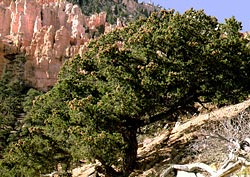
Pinus edulis, the Colorado pinyon, two-needle piñon, pinyon pine, or simply piñon, is a pine in the pinyon pine group whose ancestor was a member of the Madro-Tertiary Geoflora and is native to the United States.

Pinus monophylla, the single-leaf pinyon, is a pine in the pinyon pine group, native to North America. The range is in southernmost Idaho, western Utah, Arizona, southwest New Mexico, Nevada, eastern and southern California and northern Baja California.
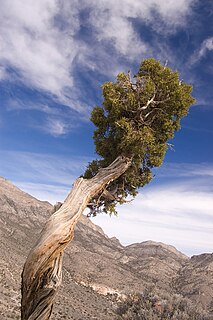
Juniperus osteosperma is a shrub or small tree reaching 3–6 m tall. It is native to the southwestern United States, in Utah, Nevada, Arizona, western New Mexico, western Colorado, Wyoming, southern Montana, southern Idaho and eastern California. It grows at moderate altitudes of 1,300–2,600 metres (4,300–8,500 ft), on dry soils, often together with Pinus monophylla.
Aristogeitonia is a plant genus in the family Picrodendraceae, described as a genus in 1908. It is native to Africa and Madagascar.
- Aristogeitonia gabonica - Gabon
- Aristogeitonia limoniifolia - Angola
- Aristogeitonia lophirifolia - Madagascar
- Aristogeitonia magnistipula - Tanzania
- Aristogeitonia monophylla - Tanzania, Kenya
- Aristogeitonia perrieri - Madagascar
- Aristogeitonia uapacifolia - Toliara Province

The Virgin Mountains are a mountain range of the northeastern Mojave Desert, located in Clark County, southeastern Nevada and Mohave County, northwestern Arizona.

Picrodendraceae is a family of flowering plants, consisting of 80 species in 24 genera. These are subtropical to tropical and found in New Guinea, Australia, New Caledonia, Madagascar, continental Africa, and tropical America. Its closest relatives are Phyllanthaceae.
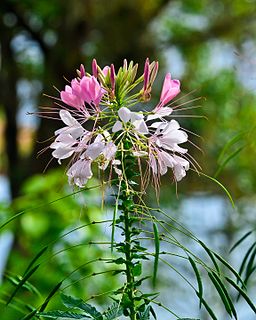
Cleome is a genus of flowering plants in the family Cleomaceae, commonly known as spider flowers, spider plants, spider weeds, or bee plants. Previously, it had been placed in the family Capparaceae, until DNA studies found the Cleomaceae genera to be more closely related to the Brassicaceae than the Capparaceae. Cleome and clammyweed, can sometimes be confused. The simplest way to differentiate the two is to compare the seedpods which project out or down on cleome and up on clammyweed.
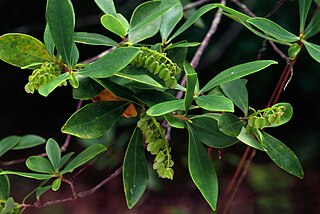
Cliftonia monophylla, the buck-wheat tree, buckwheat tree or black titi, is a tree native to the southeastern United States. It is the sole species in the genus Cliftonia.
Haplormosia monophylla, commonly known as Liberian black gum, is a species of legume in the family Fabaceae. It is found in Cameroon, Ivory Coast, Liberia, Nigeria, and Sierra Leone. It is threatened by habitat loss. It is the only member of the genus Haplormosia.
Sarcotheca monophylla is a species of plant in the family Oxalidaceae. It is a tree endemic to Peninsular Malaysia.

The Waterman Mountains are a low mountainous landform in Pima County, United States. Notable among the tree species is the elephant tree which species exhibits a contorted multi-furcate architecture; most of these froze in the cold winter of 2011. The Waterman Mountain range is in the Ironwood Forest National Monument.
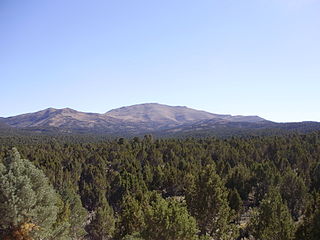
Pinyon–juniper woodland, also spelled piñon–juniper woodland, is a vegetation type (biome) of Western United States higher elevation deserts, characterized by being an open forest dominated by low, bushy, evergreen junipers, pinyon pines, and their associates which vary from region to region. The woodland's crown height may vary from less than 10 meters up to 15 meters, depending on the site. It may consist of pure stands of pinyon pine, or pure stands of juniper.

In botany, a fascicle is a bundle of leaves or flowers growing crowded together; alternatively the term might refer to the vascular tissues that supply such an organ with nutrients. However, vascular tissues may occur in fascicles even when the organs they supply are not fascicled.

Neocogniauxia monophylla is a species of orchid in the subfamily Epidendroideae. It grows in Jamaica from elevations of 3,300 to 5,300 ft.
Monophylla pallipes is a species of checkered beetle in the family Cleridae. It is found in Central America and North America.
Monophylla is a genus of checkered beetles in the family Cleridae. There are at least four described species in Monophylla.
Monophylla terminata is a species of checkered beetle in the family Cleridae. It is found in Australia, Europe & Northern Asia, Central America, and North America.
Monophylla californica is a species of checkered beetle in the family Cleridae. It is found in Central America and North America.











